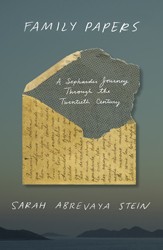In the mid-nineteenth century, Jews comprised nearly half the population of the city of Salonica, then part of the Ottoman Empire. It was a cosmopolitan port city on the Aegean Sea, with Jews involved in all aspects of its economy and levels of society. They could conduct their affairs in Ladino, their mother tongue, and had a choice of more than fifty synagogues to worship in. When the Sultan came to visit, he met with and paid his respects to the leader of the Jewish community. A century later, the Ottoman Empire was gone, the city had become part of Greece and renamed Thessaloniki. Its Jewish population had been decimated. Those who survived were scattered around the world.
Historian Sarah Abrevaya Stein chronicles the story of this Sephardic Jewish community by tracing the history of the Levy family. Their ancestors had been expelled from Spain at the end of the fifteenth century, and like so many of their compatriots, travelled east, settling in regions of the Ottoman Empire where they lived for centuries. The Levys had made their home in Salonica, and through their story, Stein writes about the Jews of Salonica, the city once known as the Jerusalem of the Balkans.
Stein, who is director of the Center for Jewish Studies, a professor of history and Chair in Sephardic Studies at UCLA, the author or editor of nine books and recipient of the Sami Rohr Prize for Jewish Literature, came across a brief memoir of a Levy family patriarch, Sa’adi Besalel Ashkenazi a‑Levi. Notwithstanding destruction and dispersion, the memoir had survived, and a great grandson eventually donated the sole copy to the National Library in Jerusalem. Stein was intrigued by it, and decided to trace the paths the Levy family took, from Sa’adi (as he was known), who died in 1903, to today’s descendants.
The memoir led her to what might be described as a family genizah, albeit a trove of letters and documents not gathered in a single location but in various sites, including Rio de Janeiro, London, Paris and Johannesburg. The largest collection of family papers is in Rio de Janeiro, and Stein was given access to it by Sa’adi’s Brazilian-born great-great grandson and his siblings, who opened their private archive to her. These family papers led her to others.
Now, thousands of documents and many years later, Stein, a remarkably tenacious, diligent researcher, has brought to life the myriad Levy family members, together with the world of a once-vital community. She has done it masterfully, with a graceful literary style and a fluidity that makes reading history as dramatic and absorbing as any novel.


